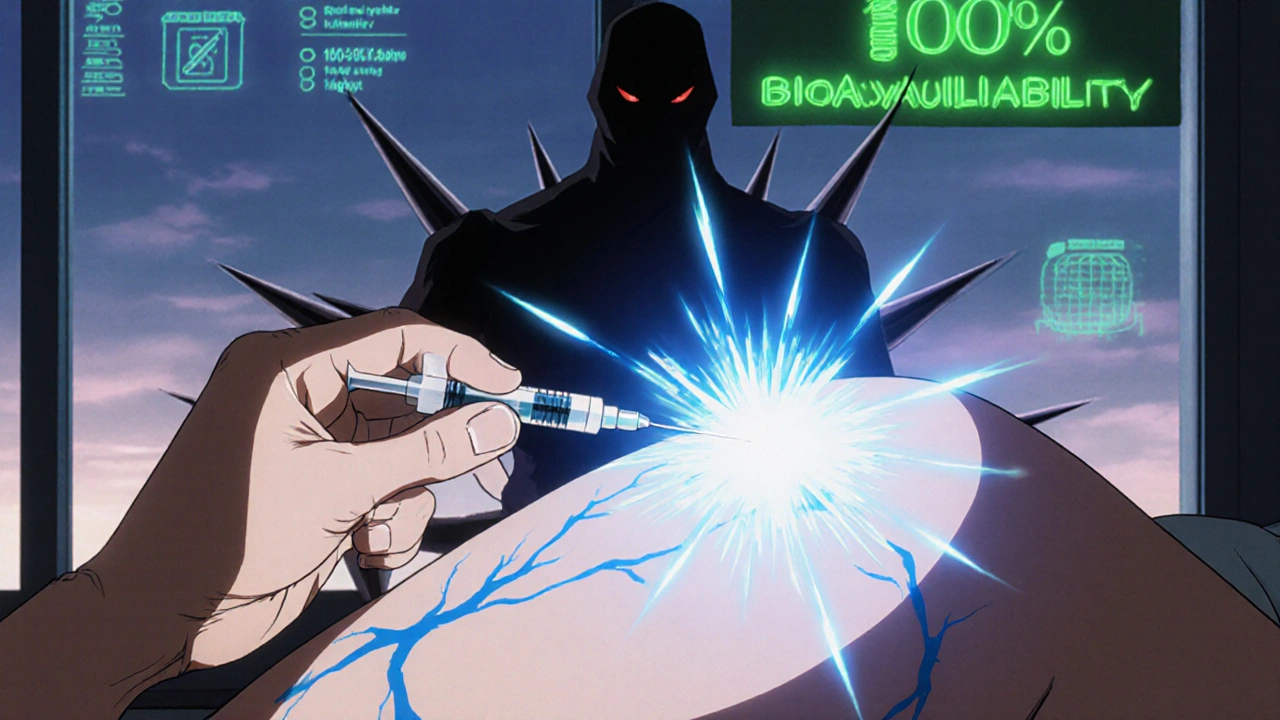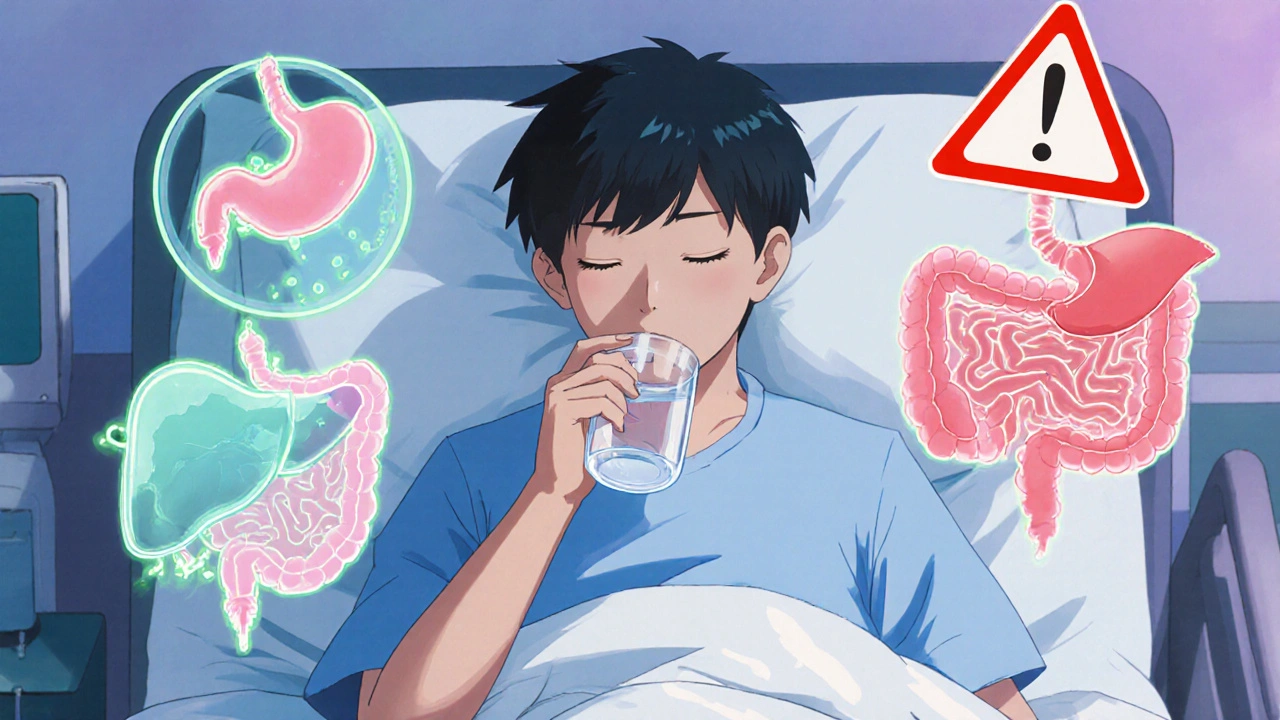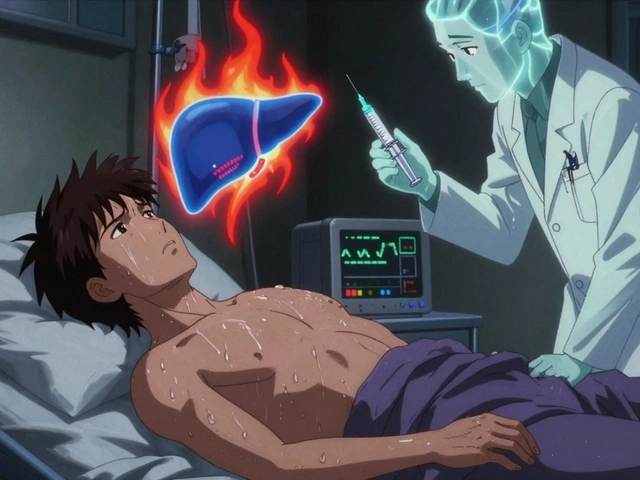Route of Administration Selection Tool
Find the Best Medication Route for Your Condition
How Your Medication Gets Into Your Body Changes Everything
You take a pill for your headache. Your doctor gives you a shot for a severe infection. You rub cream on your rash. All three treat different problems, but they also work in fundamentally different ways-and that changes what side effects you might get. The route of administration isn’t just about convenience. It’s about how much of the drug actually reaches your bloodstream, how fast it works, and what parts of your body it touches along the way.
Three main methods dominate: oral (swallowed), injectable (injected), and topical (applied to skin or mucous membranes). Each has its own set of risks, benefits, and side effects. Knowing the difference isn’t just for doctors-it matters to you, too.
Oral Medications: Convenient, But Hard on the Gut
More than 75% of all medications are taken by mouth. It’s easy. No needles. No mess. You can do it while watching TV or on your way to work. But that convenience comes with trade-offs.
When you swallow a pill, it travels through your stomach and intestines. Along the way, stomach acid breaks down some of it. Enzymes in your gut and liver destroy even more before the drug even enters your bloodstream. This is called first-pass metabolism. For drugs like propranolol or penicillin V, up to 85% of the dose is lost before it can help you. That means you need to take a higher dose to get the same effect-and higher doses mean more side effects.
The most common problems? Up to 30% of people on oral medications report nausea, stomach pain, or heartburn. NSAIDs like ibuprofen cause stomach ulcers in 1-2% of long-term users. That’s not rare-it’s expected. Some people can’t take certain drugs orally at all. If you’re vomiting, have a blocked intestine, or are too sick to swallow, oral drugs won’t work.
And it’s not just about your stomach. Oral drugs interact with food, other medications, and even your gut bacteria. About 40% of commonly prescribed pills are affected by what you eat. Grapefruit juice can turn a safe dose into a dangerous one. Coffee can speed up or slow down how fast your body processes the drug.
Injections: Fast, Precise, But Riskier
Needles scare people. That’s normal. About 20-25% of adults have real needle phobia. But when speed and precision matter, injections are unmatched.
IV (intravenous) shots deliver 100% of the drug straight into your bloodstream. Within 2-5 minutes, you feel the effect. That’s why emergency rooms use them for heart attacks, severe infections, or allergic reactions. IM (intramuscular) and SC (subcutaneous) shots take a bit longer-about an hour-but still bypass the gut entirely. No first-pass metabolism. No stomach upset. That’s why insulin, vaccines, and many biologics are injected.
But here’s the catch: you’re putting the drug directly into your body. That means any impurity, wrong dose, or bad technique can cause real harm. Injection site reactions happen in 15-20% of IM shots. Redness, swelling, pain-it’s common. In rare cases, infections or nerve damage occur. Anaphylaxis, a life-threatening allergic reaction, happens in 1 out of every 2,000 to 10,000 injections.
Long-term users face other issues. Diabetics on insulin often develop lumps under the skin called lipohypertrophy-fatty tissue builds up from repeated injections in the same spot. Biologic drugs for arthritis or psoriasis can cost $2,500-$5,000 per dose. Many patients skip doses because they can’t afford it. Others avoid them because they hate giving themselves shots.
And let’s not forget the logistics. You need training. You need sterile supplies. You need a safe way to dispose of needles. About 40% of patients don’t have access to proper sharps containers. That’s a public health risk.

Topical Treatments: Localized Action, Fewer Systemic Problems
Topical means applied to the skin, eyes, nose, or mouth. Creams, gels, patches, sprays. These are designed to act where you put them-not everywhere.
For skin conditions like eczema or psoriasis, topical steroids work better than pills. Why? Because less than 10% of the drug gets into your bloodstream. A 2022 study showed topical corticosteroids reduce HPA axis suppression (a serious hormonal side effect) by 92% compared to oral versions. That’s huge. You get the benefit without the risk.
Transdermal patches-like nicotine or fentanyl patches-are different. They’re designed to slowly release drugs through the skin into your blood. They avoid stomach issues, liver breakdown, and the peaks and valleys of oral dosing. Patients with chronic pain often prefer them because they provide steady relief. One Mayo Clinic survey found 74% of chronic pain patients liked patches better than pills.
But topical isn’t perfect. Skin isn’t a blank slate. If your skin is cracked, inflamed, or thickened (like in psoriasis), you absorb way more drug-up to 5 times more. That can turn a safe topical into a dangerous one. And if you apply too little? You get no benefit. A 2022 study showed applying less than the recommended “fingertip unit” (about half a gram) cuts effectiveness by 35-40%.
Also, not all drugs can cross the skin. Only small molecules (under 500 Daltons) work well. That’s why you can’t put a pill on your skin and expect it to work. Biologics-like antibodies for autoimmune diseases-can’t be delivered topically yet. But new tech is changing that. Ultrasound-enhanced patches now boost drug delivery by 600%, opening the door for future topical versions of injectable drugs.
Side Effects Compared: What You’re Really Getting Into
Let’s break it down plainly.
| Side Effect | Oral | Injection | Topical |
|---|---|---|---|
| Stomach upset | 25-30% | <5% | <1% |
| Injection site reaction | 0% | 15-20% | 0% |
| Systemic side effects | High (dose-dependent) | High (dose-dependent) | Low (5% or less) |
| Onset of action | 30-90 minutes | 2-60 minutes | 15-120 minutes |
| Bioavailability | 5-100% (varies widely) | 70-100% | 1-80% (depends on formulation) |
| Cost (average per dose) | $25-$100 | $2,500-$5,000 | $30-$150 |
| Adherence (patient compliance) | 50% after 6 months | 50-60% | 70-80% |
Topical wins on safety. Injectables win on speed. Oral wins on ease. But none are perfect.

What’s Changing? The Future of Drug Delivery
The drug delivery market is shifting. Topical and transdermal systems are growing fastest-projected to rise at 8.7% per year through 2030. Why? Patients want less invasive options. Companies want better adherence. And technology is catching up.
Oral tech is improving, too. New “liquid-in-capsule” systems can boost bioavailability of stubborn drugs by 30-50%. Auto-injectors now monitor needle depth to prevent tissue damage. And ultrasound patches? They’re making it possible to deliver drugs that used to require a needle.
But there’s a dark side. The ease of oral meds has led to overuse. One study found 25% of antibiotic courses are self-prescribed or misused. That’s fueling antibiotic resistance. And when patients skip injections because they’re too expensive or painful, their condition worsens. That’s not better-it’s dangerous.
The future isn’t about picking one route. It’s about matching the right route to the right drug, the right patient, and the right condition.
What Should You Do?
If you’re on a new medication, ask: Why this route? Is it the safest for me? Could a topical version work instead? Are there cheaper or less invasive options?
For chronic conditions like eczema, psoriasis, or joint pain-topical is often the best first choice. Less side effects. More control.
For emergencies, infections, or drugs that don’t survive the gut-injectables are necessary. Don’t avoid them out of fear. Learn how to use them safely.
For daily maintenance-oral is fine, but know the risks. Take it with food if instructed. Avoid grapefruit. Don’t skip doses. And if you’re having stomach issues, tell your doctor. There might be a better option.
Medication isn’t one-size-fits-all. The route matters as much as the drug itself.
Can I switch from an oral pill to a topical cream for the same condition?
Sometimes, yes-but not always. Topical versions only work for conditions that affect the skin, joints, or mucous membranes. For example, you can switch from oral prednisone to a topical steroid cream for eczema. But you can’t use a topical cream to treat a systemic infection like pneumonia. The drug must be able to reach the target area. Always check with your doctor before switching.
Why do some injections hurt more than others?
It depends on the solution’s pH, concentration, and volume. Some drugs are acidic or thick, which irritates tissue. Injecting too fast or into a nerve can also cause pain. Subcutaneous injections (like insulin) are usually less painful than intramuscular ones (like vaccines). Using a smaller needle, warming the solution, and injecting slowly can help reduce discomfort.
Are topical medications safer for older adults?
Often, yes. Older adults are more sensitive to systemic side effects-like dizziness, kidney stress, or confusion-from oral drugs. Topical treatments avoid the liver and gut, so they’re generally safer. But skin changes with age: it gets thinner and absorbs more. That means even topical drugs can become too strong. Always use the smallest effective amount and watch for skin thinning or bruising.
Why do some pills need to be taken on an empty stomach?
Food can block absorption or change how the drug is broken down. For example, antibiotics like tetracycline bind to calcium in dairy, making them useless. Some drugs need an empty stomach to dissolve properly. Others are designed to be absorbed slowly with food to reduce nausea. Always follow the label-or ask your pharmacist.
Can I use a topical cream if I have a cut or open wound?
Usually not. Open wounds absorb drugs much faster, which can lead to overdose or irritation. Some creams contain ingredients that sting or delay healing. Always check the product label. If it’s not meant for broken skin, avoid it. For wounds, use sterile dressings and follow your provider’s instructions.
Are transdermal patches better than pills for pain?
For chronic pain, often yes. Patches like fentanyl or lidocaine deliver steady levels of medication over hours or days, avoiding the spikes and crashes of oral pills. That means more consistent relief and fewer side effects like drowsiness or nausea. But they’re not for sudden pain. Also, skin irritation is common. And if the patch falls off, you might not get enough medicine. Always use them as directed.







John Dumproff
October 30, 2025 AT 00:10Just had my third corticosteroid injection this month for knee pain. The first one felt like a truck ran over my thigh. The second? Still bad, but I learned to breathe through it. This last one? My nurse warmed the vial, used a tiny needle, and talked me through it like I was her little brother. Made all the difference. Turns out, it’s not just the drug-it’s the whole damn experience.
Lugene Blair
October 30, 2025 AT 20:42Man, I used to hate pills. Always threw up after taking ibuprofen. Then my rheumatologist switched me to a topical diclofenac gel. No stomach pain. No dizziness. Just rub it on, feel the coolness, and go about my day. I still take one oral pill if it’s a really bad flare, but 80% of the time? Topical’s my new BFF. If you’ve got joint pain and hate your gut being wrecked-try it. Seriously.
William Cuthbertson
November 1, 2025 AT 02:36There is, in the act of swallowing a pill, a quiet surrender to the machinery of modern medicine-a ritual performed daily by millions who do not question the invisible journey their pharmaceuticals undertake through the labyrinth of the digestive tract, the liver’s silent filtration, the gut’s microbial ballet. We accept the inefficiency, the nausea, the grapefruit betrayal, because convenience is the opiate of the modern patient. But what if we were to reconsider not just the route, but the philosophy? Is the body not a landscape, not merely a vessel? Must every drug storm the gates of the bloodstream, or might we learn to whisper to the skin, to the mucosa, to the pores, as nature herself once did? The future of delivery may not be faster, but more reverent.
Alex Rose
November 2, 2025 AT 15:09Incorrect usage of 'bioavailability' in the table. Bioavailability is the fraction of the administered dose that reaches systemic circulation unchanged. Topical bioavailability isn't 1-80%-that's absorption rate. Bioavailability requires accounting for first-pass metabolism, which topical routes bypass entirely. Also, 'lipohypertrophy' is misspelled as 'lipohypertrophy' in the injection section. And please stop saying '1 out of every 2,000 to 10,000'-that's not a confidence interval, it's a range. Precision matters.
Vasudha Menia
November 3, 2025 AT 21:04OMG I JUST REALIZED WHY MY DAD’S SKIN GOT SO THIN 😭 He’s been on topical steroids for eczema for 15 years and never knew he was supposed to use only a fingertip unit. Now he’s got bruises everywhere. I’m sending him this article. Thank you for writing this. I cried reading the part about older adults. My grandma’s on 5 oral meds and I swear she’s just a walking side effect. Topical would’ve saved her so much pain. 💛
Mim Scala
November 4, 2025 AT 21:41When I was diagnosed with psoriasis, I refused injections. Too scary. Too expensive. Took me two years to try a patch. Turns out, the fentanyl one for nerve pain (off-label, but my doc approved it) changed my life. No more sleepless nights. No more crushing fatigue from oral meds. I don’t talk about it much. But I’m grateful. Sometimes the quietest solutions are the ones that save you.
Snehal Ranjan
November 5, 2025 AT 08:25It is a matter of profound significance that the route of administration of medicinal agents has been historically underappreciated by the lay public and even by certain segments of the medical community. The oral route although convenient is fraught with pharmacokinetic inconsistencies due to gastrointestinal variability, hepatic first-pass metabolism, and dietary interactions. The injectable route offers precision but demands discipline and infrastructure. Topical delivery represents a paradigm shift toward localized efficacy with systemic minimization. In developing nations where access to sterile equipment and trained personnel is limited, the development of low-cost transdermal technologies may prove to be a public health revolution.
Sabrina Aida
November 6, 2025 AT 10:59Are we really supposed to believe that the pharmaceutical industry doesn’t profit more from pills than patches? Pills are sold in bulk. Injections are billed separately. Topicals? They’re expensive, but patients forget to use them. So who benefits? Not you. Not me. The system is designed to keep you dependent, not healed. They want you swallowing pills for life. They don’t want you to know you can rub something on your skin and avoid the whole damn mess. This isn’t science-it’s capitalism in a lab coat.
Alanah Marie Cam
November 6, 2025 AT 14:44Thank you for the comprehensive overview. As a clinical pharmacist, I frequently counsel patients on route selection. The data presented is accurate and aligns with current guidelines. I particularly appreciate the emphasis on adherence and cost-effectiveness. For patients with chronic conditions, we must consider not only pharmacological efficacy but also psychosocial factors, including needle anxiety, dexterity limitations, and financial burden. A personalized approach to drug delivery remains the gold standard.
prajesh kumar
November 8, 2025 AT 12:39My mom switched from oral methotrexate to the auto-injector pen for rheumatoid arthritis. First week she cried because it hurt. Second week she said it felt like a tiny bee. Third week? She forgot to be scared. Now she does it while watching her favorite show. No more stomach pain. No more vomiting. Just a click and a moment of peace. I wish someone had told us this sooner. You’re right-it’s not just the drug. It’s how you get it.